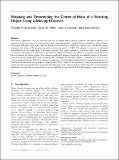Mapping and determining the center of mass of a rotating object using a moving observer
Author(s)
Setterfield, Timothy Philip; Miller, David W; Leonard, John J; Saenz Otero, Alvar
DownloadSetterfield-IJRR-2018.pdf (5.889Mb)
OPEN_ACCESS_POLICY
Open Access Policy
Creative Commons Attribution-Noncommercial-Share Alike
Terms of use
Metadata
Show full item recordAbstract
For certain applications, such as on-orbit inspection of orbital debris, defunct satellites, and natural objects, it is necessary to obtain a map of a rotating object from a moving observer, as well to estimate the object’s center of mass. This paper addresses these tasks using an observer that measures its own orientation, angular rate, and acceleration, and is equipped with a dense 3D visual sensor, such as a stereo camera or a light detection and ranging (LiDAR) sensor. The observer’s trajectory is estimated independently of the target object’s rotational motion. Pose-graph mapping is performed using visual odometry to estimate the observer’s trajectory in an arbitrary target-fixed frame. In addition to applying pose constraint factors between successive frames, loop closure is performed between temporally non-adjacent frames. A kinematic constraint on the target-fixed frame, resulting from the rigidity of the target object, is exploited to create a novel rotation kinematic factor. This factor connects a trajectory estimation factor graph with the mapping pose graph, and facilitates estimation of the target’s center of mass. Map creation is performed by transforming detected feature points into the target-fixed frame, centered at the estimated center of mass. Analysis of the algorithm’s computational performance reveals that its computational cost is negligible compared with that of the requisite image processing. Keywords: SLAM; dynamic; rotation kinematic factor
Date issued
2018-01Department
Massachusetts Institute of Technology. Department of Aeronautics and Astronautics; Massachusetts Institute of Technology. Department of Mechanical Engineering; Massachusetts Institute of Technology. Department of Ocean EngineeringJournal
The International Journal of Robotics Research
Publisher
SAGE Publications
Citation
Setterfield, Timothy P et al. “Mapping and Determining the Center of Mass of a Rotating Object Using a Moving Observer.” The International Journal of Robotics Research 37, 1 (January 2018): 83–103 © 2018 SAGE Publications
Version: Author's final manuscript
ISSN
0278-3649
1741-3176